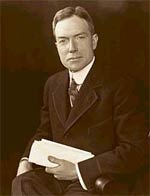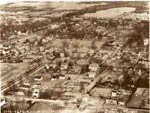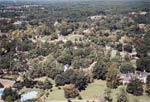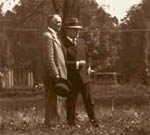Page content
"The far-visioned generosity of Mr. Rockefeller"

Colonial Williamsburg
The Reverend Dr. W.A.R. Goodwin
by

Editor's Note: The Colonial Williamsburg Foundation celebrates its seventy-fifth anniversary in 2001. The journal plans a series of stories that explore how Williamsburg's restoration came to pass. Below is the first, a never-before-published composition by the Reverend Dr. W. A. R. Goodwin.
Twice rector of Williamsburg's Bruton Parish Church, it was Goodwin who persuaded philanthropist John D. Rockefeller Jr. to finance the return of Virginia's second colonial capital to its eighteenth-century aspect. This article is an edited transcription of a phonograph recording made in Goodwin’s second-floor Wythe House office July 29, 1930.
As time goes on the American people and the lovers of liberty all over the world will appreciate even more deeply than they can possibly do at present the far-visioned generosity of Mr. John D. Rockefeller Jr. in giving to America Williamsburg Restored as an inspiration, and as a witness to events that are memorable in the history of Virginia, of the nation, and of the world. Our country will surely always hold Mr. Rockefeller in grateful remembrance for his generous philanthropy in assuming the responsibility of preserving and restoring this ancient capital. We have all been deeply impressed with the patience and generous consideration of Mr. Rockefeller. It has been a constant joy to be permitted to be associated with him in this work.
In 1926, it was our privilege to point out to him that Williamsburg was the only city celebrated in connection with pre-Revolutionary and Revolutionary events that was capable of restoration. It would be impossible to acquire a territory one mile long and a quarter of a mile wide in Boston, with Faneuil Hall as its center; or in New York, with Wall Street and Trinity church as its center; or in Philadelphia with Independence Hall as its center. Whereas, here, in Williamsburg, equally famous, there remained at least seventy colonial buildings in a town surrounded by the untouched and unmarked countryside, presenting an opportunity to create a shrine that would bear witness to the faith and the devotion and the sacrifice of the nation builders.
Williamsburg was established in 1633 as a palisaded outpost for the protection of the lower part of Virginia's Lower Peninsula against Indian invasion. The palisade ran across the Peninsula, from Archers Hope Creek to the tributaries of the York. The place was then known as Middle Plantation.
A church was established about this time, here at Middle Plantation, and continued to serve the people until 1678, when a brick church was erected. At the time of the rebellion of Nathaniel Bacon, Bacon and his councilors met here at Middle Plantation at the home of Otto Thorpe. In 1699, because of the prevalence of malaria and mosquitoes at Jamestown, and because, as an old chronicle states, "clear and crystal springs burst from champagne soil" in and about Middle Plantation, Jamestown was abandoned as the capital of the colony and the government moved to Middle Plantation.

Colonial Williamsburg
The Reverend Dr. W.A.R. Goodwin, above right, rector of Bruton Parish
Church, took the idea of Williamsburg's restoration to philanthropist
John D. Rockefeller, above, in 1926.
Francis Nicholson was at that time governor of the colony. He proposed that a city should be laid out in the form of a monogram of W and M in honor of King William and Queen Mary. The governor must have known from observation that such a plan was impossible as the tops of the W and the bottoms of the M ran into neighboring ravines. But having made his gesture of loyalty to his sovereign king and queen, he had the town surveyed by Theodoric Bland and laid it out as it is at present, naming the main street the Duke of Gloucester after the eldest son of Queen Anne and the streets on either side Francis and Nicholson after himself.
Prior to the moving of the capital from Jamestown to Williamsburg, their majesties' College of William and Mary was established here in 1693. In 1705 the Capitol was started at the east end of the Duke of Gloucester Street. In 1705, order was given for the building of the Governor's Mansion, subsequently known as the Palace. The Palace, however, was not completed until about 1712. In 1715, Alexander Spotswood, then lieutenant governor, erected the Powder Magazine. In 1710, Governor Spotswood proposed to the vestry of Bruton Parish Church that a new church should be erected, and said that if the parish would build the east and the west ends of the church, he would undertake to prevail upon the government to build the wings and the intervening part and provide pews for the governor and his council and the members of the House of Burgesses. This was done by act of the House of Burgesses as recorded in Hening's Statutes, thus making Bruton Parish the court church of colonial Virginia.
The church as built by Spotswood continued in its then-form until 1840 when a fair was given and money raised to build a wall across the church at the intersection of the nave and transept. The west end of the church was turned into a Sunday school room, the tower into a coal bin, and an entrance door to the church was placed at the east end of the building. The old pews were taken out from the church along with the old flagstone aisle.
This was the condition in which the church was found in 1902 when we came to Williamsburg. The walls had begun to disintegrate and were in a dangerous condition. They were being pressed out by the heavy weight of the roof timbers.
Through the kind cooperation of many interested friends, the parish church was restored beginning in 1905 and finished in time to have the opening celebration when the General Convention of the E piscopal Church of America met in Richmond in 1907, and its delegates could attend. Dr. W. R. Huntington, rector of Grace Church in New York served as the chairman of our advisory committee. Mr. J. Stewart Barney of New York gave his services as the architect of the restoration upon two conditions: first, that he should not receive any compensation for his work; and, second, that he should be allowed to restore the church exactly as it was in colonial days. The high pews were replaced. The pew of the colonial governor was rebuilt, and over it was hung the velvet canopy emblazoned with the name of Alexander Spotswood. The high pulpit, with the clerk's desk, was also rebuilt. The flagstone aisle was restored.
During the excavation, thirty-nine graves were found beneath the aisle and chancel of the church. Nine of these graves were identified by means of brass tacks that had been driven into the coffin wood.
At the consecration service, a Bible, which had been presented to the parish by His Majesty King Edward VII, was formally given by the Lord Bishop of London, who on this occasion paid his first official visit to his ancient Diocese of Virginia. This Bible presented by his majesty was placed upon a bronze lectern that had been given by President Theodore Roosevelt. After having completed the restoration of Bruton Parish Church, we moved to Rochester and did not return again to Williamsburg for thirteen years.

Colonial Williamsburg
Taken in 1927 by the U.S. Army Air Corps to assist the restoration,
this aerial photograph shows Williamsburg as Rockefeller first saw
it.
Upon coming back we found that the old George Wythe House, which adjoins the parish churchyard, had fallen into decay. Steps were taken by which this building might be secured, and through the cooperation of kind friends it was purchased and restored. Chapter III of the Colonial Dames of America assumed the responsibility for the purchase of the house. It was while this building, the George Wythe House, was in process of restoration, that Mr. John D. Rockefeller Jr. made his first visit to Williamsburg.
It had been our privilege to meet Mr. Rockefeller on the occasion of a meeting of the Phi Beta Kappa Society held in New York in the interest of the building of the Phi Beta Kappa Memorial Hall at the College of William and Mary. We invited Mr. Rockefeller to visit Williamsburg. He came down with his family, and it was our privilege to show him the City of Williamsburg, in which he became greatly interested.
He also visited the Wythe House and saw what was being done to preserve and restore this ancient building. It had been the home of George Wythe—the first professor of law in America, the teacher of Thomas Jefferson, of James Monroe, of Chief Justice John Marshall, and of Henry Clay. The Wythe House had also been turned over to Mr. George Washington as his headquarters during the Yorktown Campaign, and there is every probability that the Battle of Yorktown, in its final details, was planned by Washington, the Marquis de Lafayette, the Comte de Rochambeau, and General Thomas Nelson in the parlor. George Wythe was also a signer of the Declaration of Independence.
The restoration of the Wythe House very strongly appealed to Mr. Rockefeller. It enabled us to point out to him the great advantage that would result if other old and historic houses in the city, fast falling into decay, could be rescued, preserved, and restored.
It was our privilege to cooperate with him in the purchase of the property, which was needed for Williamsburg's restoration during the first eighteen months of the acquisition program undertaken. As was to be expected, the prices of property advanced as the purchase program proceeded. It is, however, interesting to remember that no single piece of property in the City of Williamsburg was purchased by any outsider or by any resident of the city for the purposes of speculation, the property all having been bought from the original owners.

Colonial Williamsburg
Taken by Colonial Williamsburg during the summer of 2000, this photograph has at least
twenty-one eighteenth-century buildings in common with the picture above.
Mr. Rockefeller did not in the beginning indicate his purpose of securing all, or of restoring the whole, colonial area of Williamsburg. He entered upon the work and proceeded with it gradually, buying certain pieces of property and finally committing himself to the restoration of the Main Building—or the Christopher Wren Building—at the college, the rebuilding of the Capitol, the rebuilding of the House of Burgesses, the restoration of the Duke of Gloucester Street, and the acquisition of Court Green and Palace Green.
We secured the services of the architectural firm of Perry Shaw and Hepburn of Boston, and also the services of Mr. Arthur A. Shurcliff, the president of the American Institute of Landscape Architects. My secretary, Miss Elizabeth Hayes, prepared a historical booklet descriptive of the history of Williamsburg to be shown to Mr. Rockefeller. Preliminary plans were drawn. I can well remember the morning when these preliminary plans were presented to Mr. Rockefeller in a room in the Vanderbilt Hotel in New York. The whole morning from nine o’clock until half past twelve was spent with Mr. Rockefeller in reviewing these plans. After lunch, Mr. Rockefeller brought back with him to the Vanderbilt Hotel his principal aide, Colonel Arthur Woods, and his legal and real estate advisors, Mr. Thomas M. Debevoise and Mr. Charles Heydt, and spent several hours explaining to them the plans that had been explained to him in the morning. It was at this time that he authorized us to proceed to buy the property within the area that has been previously mentioned.
During the first eighteen months of the Restoration it was necessary that all of the work of the Restoration in Williamsburg should be confined to my office.
The name of the donor was not known—and every possible effort was being made by newspapers and others to learn from me, and from my secretary, the name of the person responsible for the purchase of this property.
In order to conceal the identity of the donor, envelopes were often addressed to men of wealth and left in conspicuous places upon my office desk and table.
In consequence thereof, reports were circulated that the Restoration was being done by Mr. Henry Ford, by Mr. Cornelius Vanderbilt, by Mr. J. Pierpont Morgan, and by every other man in American who was supposed to have enough money to buy all of this property.
The name of Mr. Rockefeller was, however, never revealed. His name did not appear at all within my letter files.
The name of Mr. Rockefeller as the donor of the funds for the Restoration was not made known until early 1928.
At that time it became necessary to negotiate with the city for the acquisition of the Palace Green, the Court Green and other property owned by the city. It seemed advisable, therefore, that the city should know to whom this property was to be turned over, and, with Mr. Rockefeller's consent, his name was announced at a mass meeting conducted in the high school building that June when the citizens assembled to vote on the question of authorizing the proper authorities to turn over the city property to the Restoration.

Colonial Williamsburg
Goodwin and Rockefeller seemed to be gazing into the future when a Virginia Chamber of
Commerce photographer snapped them behind the Wythe House in 1928.
As the work proceeded, it became more highly organized. The Restoration is deeply indebted to the fidelity of Mr. Kenneth Chorley who for the past year has been acting as the representative of President Arthur Woods's office here in Williamsburg.
Mr. Rockefeller was extremely anxious that the work should be done in accordance with historic verity. To this end research work was organized and research workers were sent to England and to France to study the records in the British foreign record office, in the libraries in the universities of England, and in the military offices and historic libraries of France. As a result of this work, information indispensable to the Restoration was secured.
The work has proceeded with care and with great caution. The work is proceeding slowly. No time limit has been fixed for its completion. It is believed that it is best not to release for publication plans or descriptions of the work as anything done is liable to change in the light of further evidence.
It is fortunate that Williamsburg, which is being restored, will bring to mind, and perpetuate the simple architectural designs of that period in Virginia and American history before wealth had become obvious.
The results of the Restoration will be far reaching in their significance. It is interesting to think of the significance of:
"The restoration of the Christopher Wren Building, the oldest academic building upon the American continent, over which Washington presided as chancellor, associated with the school days of Jefferson, of Chief Justice Marshall, of the Randolphs, the Tylers, the Carters, the Dabneys, the Carrs and other men famous in Virginia history." The restoration of the Capitol building where George Mason's bill of rights was adopted, where the resolution was passed instructing the Virginia delegates in the Continental Congress to offer there a resolution to declare the colonies free and independent states, where Patrick Henry delivered his Brutus speech. "The restoration and the furnishing of the colonial Governors Palace and the preservation and restoration of the historic homes of this city will constitute a treasure the value of which will increase with the passing years.
The Restoration will be educational. Modern windows will open on vistas stretching through the distance into the past.
The Restoration will be inspirational, in that it will recall to present and to future generations the faith and the sacrifice of the nation builders.
Through this Restoration, a shrine will be created that will serve to stimulate patriotism, that will develop in American citizens a deeper love for their native land as they come to understand the things that happened here, without which the foundations of the federal republic could not have been securely laid.
After helping Rockefeller to secure properties in Williamsburg's Historic Area, Goodwin served as the Restoration's local agent, as well as rector of Bruton Parish. He died in 1939 and is buried in the chancel of the church.
